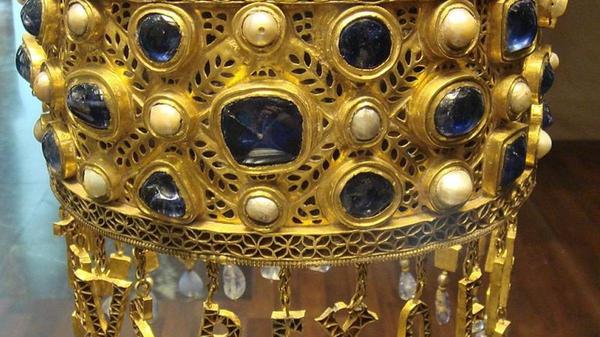Guarrazar, the Visigoth treasure that is almost lost twice
In the National Archaeological Museum, half a dozen votive crowns can be admired, including an exceptional one, that of recessvinto.These pieces, known as the Guarrazar Treasury, have a curious story, in which there is no lack of elements of a novel.But the impressive current set is barely a part of the Visigoth jewels that were discovered in the summer of 1858.And his story begins a long time ago, with the Muslim invasion of the Iberian Peninsula.
In 711, both the Visigoth minority and the majority of Hispano -Roman origin practiced Christianity, especially in its Catholic variant, turned into a state religion from the conversion of Recaredo into 589.There were, however, remains of the Arian variant.Nor were important groups that continued with ancient pagan beliefs, as San Isidoro collected in their etymologies.
It was in this context that the introduction of Islam occurred.Was it a great alteration?At first, at least, the peninsular society did not worry too much about the new creed.The Visigoth kingdom, with capital in Toledo, lived in endless bowel struggles.King Witiza's children disputed Rodrigo's throne, so they called Muslims in their aid.In theory, these had to cross the Strait of Gibraltar and return to North Africa with as many loot as possible.
Those who fled to Asturias hid their property, convinced that they could return and recover them
The facts developed very differently.After the defeat and death of Rodrigo near La Laguna de la Janda, in the traditionally known as Battle of Guadalete, some fights were fought.Unable to offer resistance, the kingdom of Toledo disappeared in a few years.However, he remained alive among those who took refuge in the mountainous areas of the Peninsular North, determined not to submit to the power of Muslims.
It was still believed that his domain was going to be something temporary.Therefore, some of those who fled towards Asturias hid their most precious goods, convinced that, after some time, they could return and recover them.Soon it was going to be evident that this idea was an immense mistake.
The origin to debate
It was probably toledo clergymen who hid the valuable pieces of the Guarrazar Treasury in some excavated graves next to a cemetery.It was mainly votive crowns and crosses that adorned their temples.They were hidden in a place located two leagues from Toledo, known as the Guarrazar orchards for being watered with the waters of a spring of that name.
Recent excavations carried out by specialists Juan Manuel Rojas, Juan Luis García Vacas and Raúl Catalán, in a project entitled “Guarrazar: Archeology and new resources”, have revealed that in Visigoda era an important construction was raised in that area, possibly a religious complex-palatial.For the remains found, you must date the second half of the seventh century.The buildings could be associated with the church of Santa María de Sorbaces, a temple referred to in the Sonnica cross, one of the jewels found.
These discoveries lead us to ask some questions.It has been traditionally argued that the Treasury of Guarrazar.
The richness of jewels, worthy of great Toledo temples such as the Basilica of San Pedro and San Pablo, where the famous councils of Toledo would be held, it could be explained from the existence of a palatial building that would serve as a temporary residence of the monarchs andConference to the religious enclosure a privileged range.
The crosses were decorative or used in certain liturgical ceremonies
Beyond that the treasure came from one or another, one thing is clear: numerous pieces of Visigothic goldsmiths were hidden in graves.

The votive crowns were rich works caranted in gold and adorned with precious and semi -precious stones.The relevant kings or characters offered them to the Church in compliance with a vote or a promise.They bore the name of the offeror, and hung from some chains that served to hang them from the temple's roof.
The crosses were decorative or used in certain liturgical ceremonies.They could be carved in gold and adorned with rhinestones or being made of wood covered with gold plates, also adorned with gems and pearls.
The development of events made this treasure never recovered by those who hid it and remain hidden for more than a thousand years.The refugee Christians in the Northern Mountains slowly advanced south, occupying the lands of the Valle del Duero and the Plateau in the following centuries.Toledo would not return to Christian domain until she was conquered by King Alfonso VI de León in 1085.For that date, the memory of the valuable pieces of Guarrazar was already lost.
Catastrophic discoverers
We will have to take a leap in time and wait for, in 1858, during the reign of Isabel II, there is a casual finding.It happened at the end of August, when Francisco Morales and María Pérez, a marriage from Guadamur, returned from Toledo.There, a daughter of Maria's first link, Scholastica, had performed the final test to obtain the title of First Letters Teacher.
That day, a strong storm rolled the earth.Near his people, at the height of the source of Guarrazar, Scholasticism had a pressing need.At that time, with the sky already clear, the last rays of sun allowed him.
He called his parents and removed the slabs that covered a pit of just over a meter deep and seventy by seventy centimeters.I was full of gold jewels and precious stones.The Labriegos family decided not to disseminate their finding for fear of complications that could derive whether they announced the treasure.They knew that those pieces were works of art and could be seized.They would have had certain rights to possess the farm where the property was, but that was not the case.
The secret was going to cause an authentic artistic catastrophe.To get rid of those jewels, the Morales extracted the stones that were set and chopped them.We do not know what part of the treasure was, in this way, to little scrupulous Toledo jewels, who acquired the pieces to melt them.
Less than an hour to go. Here's what we're giving you today; 1.How to create the self image a Business Consult ... https: // t.CO/WQCA92GUSU
— Rebecca Bonnington Wed Jul 07 14:05:46 +0000 2021
The government was accused of not acting properly in defense of historical-artistic heritage
On the same dates, another inhabitant of Guadamur, Domingo de la Cruz, found another pit of similar characteristics, close to the first.He also kept him a secret for fears identical to those of his neighbors.As in the previous case, he chose to destroy the jewels and try to get the maximum possible economic performance of the pieces.When he admitted the finding three years later, only the Visigoth monarch of the VII century remained in his possession, and that of an abbot named Theodosius, as well as the cross of the Bishop Lucecio.
Speculate
The situation changed when the discovery made by Scholasticism came to the knowledge of a French.His name was Adolphe Hérouart.He was an ancient fighter of the Carlist side that lived in Spain for many years.At that time, after moving on to the Elizabethan army, he taught at the Toledo Military School.
Herouart came into contact with a famous jeweler, José Navarro, author of the Crown of Isabel II.Both acquired the jewels of the Morales family that had been saved from destruction and decided to sell them in France.They hoped to obtain a better price, but they also took into account other issues.
They weighed the personal circumstances of Navarro, who had taken five years to collect the crown made for the queen and was about to ruin.Adolphe Hérouart, meanwhile, was influenced by its Gallic origin, although it already possessed Spanish nationality.
In Spain there was news of the existence of the treasure through the French press.Henri Lavoix published in 1859 an article entitled “Les Couronnes de Guarrazar” in the Parisina L’Illustration magazine.In him he referred the finding of jewels in a place near Toledo and the purchase of nine pieces, mainly votive crowns, by the Cluny Museum.This institution had opened its doors as a medieval history museum a few years before.
The Hispanic press echoed the news immediately.Numerous articles about the circumstances of the discovery circulated, with harsh criticism of the cabinet chaired by Leopoldo O'Donnell.The matter soon arrived at the Congress of Deputies, because the importance of that treasure was extraordinary.Not only for the great artistic value of the pieces, but also because they belonged to a historical period of which very few vestiges had been preserved.
The scandal was monumental.In the political forums, strong debates were generated, in which the government was accused of not acting properly in defense of the historical-artistic heritage of the country.The need to provide Spain with a museum that houses the great artistic pieces of other times, imitation of those that already existed in France or Great Britain.
The long return
For its part, the Royal Academy of History commissioned one of its most prominent members, José Amador de los Ríos, a professor of the Central University, to make an excavation in the field where the finding had taken place and prepare the corresponding report.
His research revealed a small enclosure that was considered a funeral chapel, noteding an inscription that indicated its use as burial of one Crispinus.He was near the Guarrazar spring, so some remains associated with the source came to light.
The French were not willing to give up some pieces of extraordinary historical and artistic value
Amador de los Ríos considered them belonging to a delubrum, denomination that, according to San Isidoro in their etymologies, was the one that was given to the temples of the Roman era gifted from fountains where the faithful were purified before entering the sacred enclosure.
Among the residents of Guadamur and other nearby towns, the news spread that large wealth were hidden in the area.A kind of gold fever was then extended: many people began to dig on their own, causing great damage.
Before the discovery of the valuable jewels, Adolphe Hérouart bought one of the orchards of that payment was made public.I hope that there were similar graves.Possibly took into account the legislation in force, which granted important rights to the owner of the place where there was a discovery of archaeological value.
In fact, in the judicial process that opened as a result of these events, herouart tried to confuse the authorities claiming that the treasure that had been discovered was on a farm of his property.For this false testimony he held a strong controversy with Amador de los Ríos, who accused the French of liar and fake.
The presence of jewels in France led the Spanish government to raise a diplomatic claim, in an attempt to undo the purchase made by the Cluny Museum.The result of this management was a resounding failure, since the French were not willing to easily give up some pieces of extraordinary historical and artistic value.They constituted the most important sample, until that date, of the goldsmithing of the Germanic peoples that invaded the Roman Empire of the West.
Many years later, during World War II, six of the nine crowns that were exhibited at the Cluny Museum returned to Spain.Vichy's puppet government, pressed by the Nazis, closed an agreement with Franco.In exchange for some pieces, Spain received the lady of Elchey the Immaculate of Murillo, a painting stole by Marshal Sault during the War of Independence, and the six votive crowns that are presented today in the National Archaeological Museum.
A robbery never clarified
At present, what remains of the Guarrazar Treasury is stored in three spaces, two Spaniards and one French.In the National Archaeological Museum, most of the set is preserved: six crowns, five crosses and a pendant.In the Royal Palace of Madrid a crown, a gold cross and a stone with the recorded image of the announcement are saved.Finally, in the Cluny Museum, in Paris, three crowns, two crossings and gold earrings can be seen.
One of the most important jewels that were part of the Guarrazar Treasury was the so -called Suintila crown.The donation to the Church was made by the Visigoth monarch of this name, which reigned between the years 621 and 631.His greatest achievement was the expulsion of the Byzantines, settled, since the time of Emperor Justinian (527-565), in the southern area of the Iberian Peninsula.
That crown, along with other pieces, was delivered to Queen Elizabeth II by Domingo de la Cruz Figueroa in exchange for a sum - it is also argued that it was a gift to the sovereign - and was deposited in the armory of the Royal Palace.There he remained, protected by a showcase, until he was stolen on the night of April 4, 1921.The investigations made by Inspector Antonio Lino were useless.Until today it has not been possible to find your whereabouts.
This article was published in number 611 of the Magazine Historia y Vida.Do you have something to contribute?Write us to writinghyv@historyyvida.com.
Relacionadas






![47 best antiage nutritive cream in 2022 [based on 326 reviews] 47 best antiage nutritive cream in 2022 [based on 326 reviews]](https://website-google-hk.oss-cn-hongkong.aliyuncs.com/drawing/article_results_6/2022/2/27/1918fc37c66ad30564173e69d9df88a0.jpeg)
